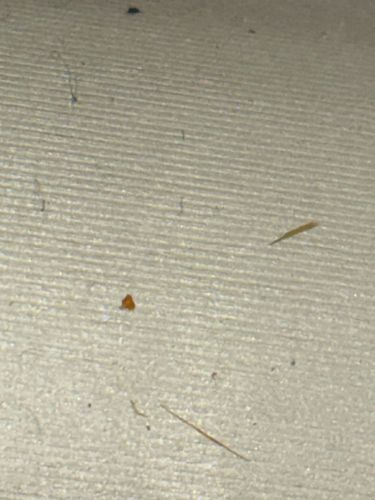Unable to definitively identify from the provided image. The image is too blurry and lacks sufficient detail to determine the exact insect or bug. The small, elongated, and somewhat fuzzy shapes could potentially be: 1. Carpet beetle larvae (Dermestidae family) - some species are fuzzy. 2. Dust mites (Dermatophagoides spp.) - though they are microscopic, aggregated dust that contains them can appear like this. 3. Lint or other common household debris, especially given the texture of the surface.
Scientific Name: Unable to definitively identify due to image clarity.
Order & Family: Unable to definitively identify due to image clarity.
Size: Given the extremely low resolution and blur, estimating size is impossible. The 'objects' appear very small in relation to the textured surface. If carpet beetle larvae were present, they would typically be a few millimeters in length. Dust mites are microscopic (0.2-0.3 mm).

Natural Habitat
If carpet beetle larvae: Indoors, especially in carpets, rugs, upholstered furniture, closets, attics, museums, and anywhere animal-based products are stored. If dust mites: Ubiquitous in human dwellings, particularly in beds, bedding, upholstered furniture, carpets, and curtains, thriving in warm, humid environments.
Diet & Feeding
If carpet beetle larvae: Keratin-based materials such as wool, silk, fur, feathers, leather, dried animal products, stored food products, and even synthetic fibers. If dust mites: Primarily dead skin cells shed by humans and animals, as well as other organic detritus found in household dust.
Behavior Patterns
Given the lack of detail, if these are carpet beetle larvae, they are often found in dark, undisturbed areas. They are typically slow-moving and prefer to stay hidden within their food sources. Adult carpet beetles are often attracted to light and can be found near windows. If these are dust mites, they are microscopic and their 'behavior' is simply existing within dust, feeding on organic detritus. If these are carpet beetle larvae, they undergo complete metamorphosis.
Risks & Benefits
If carpet beetle larvae: Risks include damage to textiles, clothing, carpets, and stored goods. They do not bite humans but can cause skin irritation in sensitive individuals. No known benefits in a household setting. If dust mites: The primary risk is triggering allergies and asthma symptoms in sensitive individuals due to their fecal matter and body fragments. They do not bite or transmit diseases. No direct benefits to humans.
Identified on: 8/29/2025